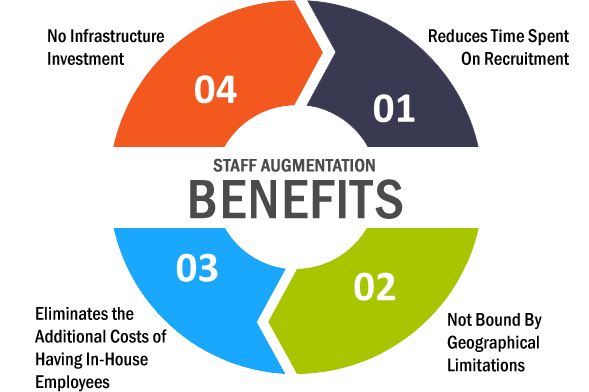In these accelerated times, companies need to offer satisfactory and differentiated experiences to their customers. This requires launching services, functionalities and products that respond to their needs, and which in fact must often be channeled through software applications and solutions.
This means that the IT and development areas of companies are under great demand, and often accumulate requirements to meet the needs of the business. To solve these bottlenecks, companies can resort to an outsourcing modality called ‘staff augmentation’.
Why Staff Augmentation?
Staff augmentation helps to shore up projects with trained personnel who are added to carry out specific initiatives. Staff augmentation is one of several possible outsourcing models. This variant suggests the hiring of technological experts for a given project within defined deadlines and costs. Specialists are hired to fill gaps in certain technological competencies.
There is a wide range of scenarios in which companies can make use of staff augmentation: to increase manpower when meeting a peak in work, as a transit to provide capacity instead of hiring a permanent team, to obtain specialized skills that will be required over a period of time, among other cases, and it is common to use this modality to add skilled people in order to develop program web or mobile apps, for example. What is staff augmentation will be described in more detail in the following.
What is staff augmentation?
The staff that is added to a company is employed directly by the supplier. In other words, staff augmentation implies the incorporation of external personnel on a temporary basis to increase the organization’s capacity and be able to respond to the demands of the business and commercial objectives.
This outsourcing modality can help to solve or alleviate problems such as the lack of IT professionals, shortage of specialists in a specific technological discipline, inability to scale the business or difficulties in applying innovation, etc. It is usually effective when used for single projects with limited time frames.
What is staff augmentation allows hiring technological talent in different areas, finding candidates that fit the specific requirement and adding them to the team at the moment they are needed. Developers can be incorporated from the very beginning of the project, or already in the final stages. With their contribution, projects can be launched more quickly and with greater chances of success.
It should be noted that with this model, project management is not delegated: the project is managed and controlled internally. What is outsourced are software development tasks. In general, we are talking about programming, configuration and implementation of business solutions.
IT staff augmentation
In an uncertain and dynamically changing business environment, the need for IT services professionals is continuously growing. However, the shortage of experienced software developers is the reality that today’s market must face and adapt to.
The increasing demand on projects, force companies to rethink their methods and concepts.
New services to expand the software team abroad, for example, play an important role in this. Companies are realizing the software benefits and are able to adapt to their customers. The most important aspects are higher productivity and flexibility. Especially compared to other outsourcing models, IT Staff augmentation can greatly increase the workload of developers.
This is because they work full-time on one project and do not jump back and forth between different customers. The integration into the company environment and the team feeling ensure a high level of motivation. This means that the developers are much more involved in the project and are interested in its success.
The protection of intellectual property is extremely important. Traditional offshore outsourcing can no longer comply with the strict regulations. With IT staff augmentation, companies receive a remote team that is directly under the responsibility of the client company. Therefore, the ownership rights are 100% with the contracting partner.
Staff augmentation services
Staff augmentation services are one type of outsourcing services in which a software company provides its technicians in the form of external experts, usually on the basis of a time contract. In practice, the outsourcer’s internal team is equipped or augmented with third party specialists who work at the client’s site for the duration of a specific project.
With the help of staff augmentation services, companies can save costs related to recruitment, payroll and project implementation. This model is also easily scalable – it’s easier to terminate such a partnership compared to terminating an employment contract; therefore, it’s easy to quickly ramp up or down staff as needed. In addition, it allows minimizing the formalities with HR and the employment relationship.
Staff augmentation vs managed services
Staff augmentation is an IT outsourcing strategy that can be compared to ‘employee borrowing’. Here, a company hires a staffing company that provides businesses with one of its IT employees. This employee is fully integrated into the daily business for an agreed period of time.
Managed Services, on the other hand, concerns only a small part of the daily business. The overall IT structure and many of the processes therefore remain with the contracting company itself when Managed Services are used. Managed services are precisely defined services that an IT service provider or system house provides for its client. These can include regular checks of the IT infrastructure in order to identify and solve any problems that arise.
Staff augmentation vs managed services describes the difference between tasks delegations. Outsourcing describes the complete outsourcing of corporate IT to an external IT service provider. In the case of managed services, only certain areas are usually handed over. And even if IT is handed over in its entirety, the assets (infrastructure, employees) remain in the company.
With staff augmentation, the IT world still belongs to the company and is not outsourced to an external service provider. With complete outsourcing, companies give the IT control into other hands. With managed services, companies avoid this loss of control. Because companies can determine the degree to which they outsource their IT services and their operation, they make themselves less dependent. They retain control over the overall structure and processes.
Staff augmentation vs managed services helps companies bridge difficulties in finding well-trained IT specialists. Both alternatives help companies avoid this problem by giving direct access to a pool of highly qualified specialists.
Lastly, many IT processes consume a lot of time, such as creating backups or installing updates. By outsourcing these time-consuming routine tasks, internal employees can concentrate on their core tasks. This also benefits the reorganization of IT as an internal service provider.
Concluding staff augmentation
When corporations find themselves in a situation where their team or teams need expert help or to replace any of the current collaborators and the company has little flexibility in hiring own personnel, they can resort to an outsourcing modality called ‘staff augmentation’, which will allow them to reduce time and costs but increase specialist labor force at the same time, and also to have expert personnel focused on important activities for a defined period of time.




